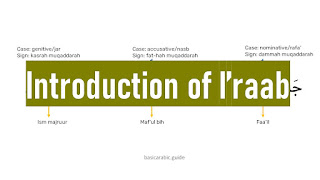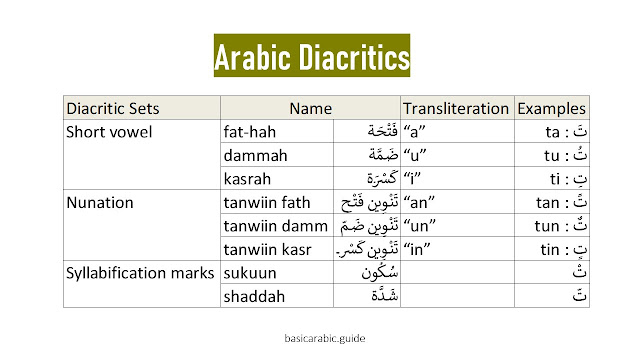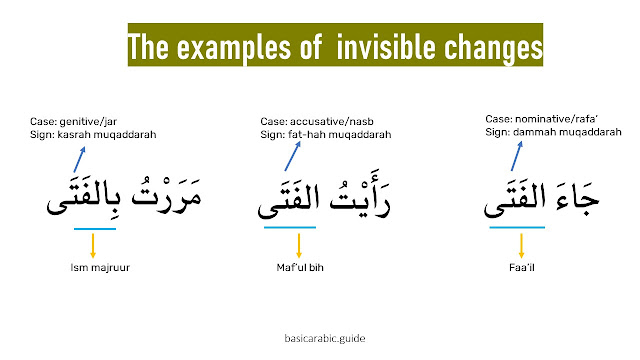Case Ending in Arabic: Introduction to I'raab | إعراب
Introduction
The end-case analysis of Arabic sentences is studied when you learn Arabic Grammar. This process is called i'raab (إِعْرَاب).
The process includes analyze the position of each word by the use of certain signs namely diacritical mark for each position. Then we'll know the role of each word in the Arabic sentence.
The process is also called syntactic parsing, generally known as علم النحو ('ilm nahw) or إعْرَاب (i'raab).
The syntactic parsing process is done by placing the proper diacritical mark at the end-case of each word along with an appropriate justification.
This knowledge is important because an incorrect i'raab leads to a misunderstanding of the exact meaning of a sentence.
Before learning i'raab comprehensively, let's take a look at the basic Arabic diacritics.
Three sets of Diacritic
1. Short vowel
Short vowel comprises:
a. fat-hah (فَتْحَة) "a".
b. dammah (ضَمَّة) "u".
c. kasrah (كَسْرَة) "i".
2. Nunation
Nunation comprises:
a. tanwiin fath (تَنْوِين فَتْح) "an".
b. tanwiin damm (تَنْوِين ضَمّ) "un".
c. tanwiin kasr (تَنْوِين كَسْر) "in"
3. Syllabification marks
It comprises:
a. sukuun (سُكُون).
b. shaddah (شَدَّة).
Notes:
- Vowels in Arabic is called الحَرَكَات (al-harakaat).
- Sukuun indicates the absence of a vowel.
- shaddah is doubling of a consonant, it occurs twice without a vowel in between.
Now, let's learn the definition of irab and the types of irab and their characteristics.
What is i'rab?
الإِعْرَب : هُوَ تَغْيِيرُ أحْوَالِ أَوَاخِرِ الكَلِمِ لِاخْتِلاَفِ العَوَامِلِ الدَّاخِلَةِ عَلَيْهَا لَفْظًا أوْ تَقْدِيْرًا
I'raab: A change of the state of the endings of a word (case endings) that is caused by factors (governing words) that enter into the word, either visibly (visible changes) or covertly (invisible changes).
Notes:
1. Definition of 'awaamil
- عَوَامِل ('awaamil) is a word that governs/causes the state of ending of another word changes.
- عَوَامِل is plural, the singular form of عَوَامِل is عَامِلٌ ('aamil).
2. A word by word translation
a. تَغْيِير : switching; changing
تَغْيِير is masdar (مصدر) of the verb غَيَّرَ - يُغَيِّرُ
b. أَحْوَال : states; conditions; circumstances
أَحْوالٌ is plural, the singular form of أَحْوالٌ is حَالٌ
c. أَوَاخِر : last; end
d. كَلِم : words
The synonym of كَلِم is كَلِمَاتٌ (kalimaat).
كَلِم is plural, the singular form of كَلِم is كَلِمَةٌ (kalimah).
So, تَغْيِيرُ أَوَاخِرِ الكَلِمات means "declension".
e. اخْتِلاَف : variation; diversity; difference; contrast; disagreement
f. دَاخِل : coming into; getting into; entered in
g. لَفْظًا in grammar context means visible.
h. تَقْدِيْرًا in grammar context means invisible.
The examples of visible changes
1. جَاءَ زَيْدٌ (jaa-a zaidun).
Zaid came.
2. رَأَيْتُ زَيْدًا (ra-aitu zaidan).
I saw Zaid.
3. مَرَرْتُ بِزَيْدٍ (marartu bizaidin).
I passed by Zaid.
Have a look at the word "زَيْدٌ" (zaid). There are three conditions at the ending of the word Zaid, they are tanwiin dam (zaidUN), tanwiin fath (zaidAN), and tanwiin kasr (ZaidIN).
The ending changes of the word "زيد" is visible. We can see obviously, they are dammah "u" (with nunnation), fat-hah "a", and kasrah "i".
In Arabic grammar:
a. زَيْدٌ is in rafa' (رفع) condition or nominative case. It is called marfuu' (مرفوع).
b. زَيْدًا is in nasb (نصب) condition or accusative case. It is called mansuub (منصوب).
c. زَيْدٍ is in jar (جرّ) condition or genitive case. It is called majruur (مجرور).
We learn marfu', mansub, and majrur in the next lesson, in shaa Allah.
The condition changes are caused by 'awaamil (governing words), read the explanation below.
1. زَيْدٌ is marfuu', because the 'aamil fi'l maadi ma'luum (فعل الماضي المعلوم).
The fi'l madi جَاءَ needs the doer (the one who do the action).
The doer in Arabic is called faa'il (فَاعِل).
The faa'il must be in nominative case (rafa'), so the ending of the word زيد is dammah "u". => زَيْدٌ
2. زَيْدًا is mansuub, because the 'aamil fi'l madi muta'addi (the verb that needs the object).
The object in Arabic is called maf'ul bih (مفعول به).
The maf'ul bih must be in accusative case (nasb), so the harakat of the word ends with fat-hah "a" => زَيْدًا
3. زَيْدٍ is majruur, because the 'aamil harf jar "ب".
Harf jar "ب" makes the the next word (زيد) to become majruur (in genitive case), so the harakat of the word زَيْد ends with kasrah "i" => زَيْدٍ
The examples of invisible changes
1. جَاءَ الفَتَى (jaa-a al-fataa).
The boy came.
2. رَأَيْتُ الفَتَى (ra-aitu al-fataa).
I saw the boy.
3. مَرَرْتُ بِالفَتَى
I passed the boy.
Have a look at the word "الفَتَى". الفَتَى is ism maqsuur (الاسم المقصور).
It seems that the word الفَتَى has the same ending condition, but actually the word الفَتَى in first sentence, second, and third one are in different condition (case).
In the first sentence, الفَتَى is marfuu', the sign of the rafa' is dammah muqaddarah (invisible dammah).
In the second sentence, الفَتَى is mansuub, the sign of the nasb is fat-hah muqaddarah (invisible fat-hah).
In the third sentence, الفَتَى is majruur, the sign of the jar is kasrah muqaddarah (invisible kasrah).





No comments:
Post a Comment